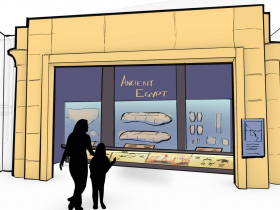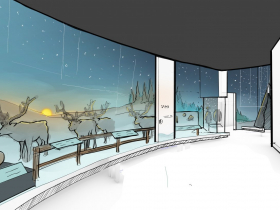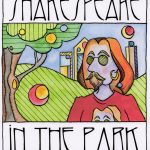New Museum Gallery Digs Into World Landscapes and Societies
Grasslands, deserts, arctic areas, mountains and islands in planned exhibit.

Grasslands Hall in Living in a Dynamic World gallery. Courtesy of Milwaukee Public Museum.
The latest permanent gallery for the new museum revealed by the Milwaukee Public Museum will show visitors world landscapes and the societies that populate them.
It’s called “Living in a Dynamic World” and will include new exhibit halls showcasing five different landscapes around the world: desert, arctic, islands, grasslands and mountains. MPM Inc., the non-profit that operates the public museum, also gave a first look at features of the new museum it is calling “mixing zones.” The new museum exhibits are being designed by Thinc Design, an agency based in New York City.
MPM has slowly revealed five of the new permanent exhibits it is planning for its future museum at the corner of N. 6th St. and W. McKinley Ave. That $240 million new facility that’s being designed is a five-story, 20,000-square-foot building. The architects have designed a building that’s supposed to resemble Wisconsin’s Mill Bluff in Mill Bluff State Park.
Dr. Ellen Censky, president and CEO of the museum, said this latest gallery, “really underscores the future Museum’s overarching theme: how the wonders of the world sit at the intersection of nature and culture.”
Each landscape will feature an exhibit on a culture found in the landscape and the people that created it. Alongside that, each featured culture will have a “cultural counterpoint” this will be another society found in the same type of landscape. This is intended to show the “distinguishable characteristics” of cultures found in that specific landscape, as well as the ways the two cultures adapted to their surroundings differently.
“Through immersive environmental scenes and our vast collection of global artifacts,” Censky said. “we are creating exhibits that examine the way life shapes and is shaped by our natural landscape.”
The final gallery unveiling will be May 23, featuring the new “Rainforest” gallery
Living Globe
At the center of the gallery will be an exhibit called “Living Globe” that will have “a massive globe, animated with various global systems, such as ocean currents, seasonal migrations, trade routes and seismic activity zones.”
Deserts
The Desert Hall will focus on the diversity of plants and animals living in northeastern Arizona and the culture of the Hopi Nation, a people indigenous to the region. It will feature a traditional Hopi dwelling and Hopi pottery from the museum’s collections.
Additionally, future visitors to the new exhibit will find a rattlesnake, and, if they look carefully, a snake button, said Oronde Wright, senior designer at Thinc Design.
The “cultural counterpoint” in the Desert exhibit will be ancient Egypt. It will look at how ancient Egyptian society was in part shaped by the desert and will feature funerary objects and a sarcophagus.
Grasslands
This hall will dive into societies that have populated grasslands around the world, though they have yet to be announced by the museum. Though it will take a particular look at the African Serengeti, and feature Timba the Elephant and Simba the Lion, two displays that are shown at the existing public museum.
It will “dig into the multiplicity of cultures that live in that part of the world, and examine how the landscape, the megafauna, the vegetation, has impacted those cultures, and vice versa,” said Helen Divjak, senior curator with Thinc Design.
Arctic
The cultural case study for the Arctic Hall will be the Sami people. “One of the collections that is so rich at the Milwaukee Public Museum is their collection of Sami cultural material,” Divjak said.
The Sami are made up of several groups of people, Divjak said, but the museum will focus on the Nordic Sami and their relationship to reindeer.
“A key immersive scene will situate visitors on a vast northern-European tundra during a midsummer night, where dozens of reindeer will munch on moss against the background of a dusky pink sky, the summer sun still above the horizon at midnight,” the museum said in a statement.
The cultural counterpoint to the Sami will be the Inuit people of the North American Arctic with an exhibit that tells a story about how people adapted to their frozen environment and found food.
Islands
The Islands Hall will look at cultures found in the South Pacific and a group of people indigenous to Japan’s Island of Hokkaido, the Ainu.
“In a series of scenes that start on the surface of the water and progressively dive deeper into the sea, visitors will learn about maritime navigation and how people have gotten around islands,” MPM said.
It will also feature an immersive look at fishing culture and tools. As a visitor walks deeper into the exhibit, it’s designed to feel as if the water level is rising, Wright explained. “So as we go even deeper the water goes above our heads; we’re able to see a Taiwanese boat, as well as some object models of what undersea life looks like.”
Mixing Zones
The new mixing zones will give visitors “rare, behind the scenes” views into the museum’s collections, according to MPM.
“Items on display in the Mixing Zones will be frequently rotated, allowing visitors to see new-to-them items regularly and allowing the Museum to layer in even more educational opportunities as visitors gain access to items and ideas that have previously not been visible,” MPM said.
One will be a three-story glass showcase visible from multiple levels of the museum and featuring a wide array of items “ranging from ancient fossils and glittering gems, to boats, textiles, children’s toys and taxidermied specimens, such as Samson the gorillas,” MPM said.
Another is called the “Burke Foundation Mixing Zone,” which will be created thanks to a $2 million donation from the Burke Foundation. This mixing zone will feature an “enormous window” into the museum’s collections storage.
“And so many of those objects are not always on display, and we wanted to give visitors an opportunity to peek behind the scenes, and see where these objects are stored,” Divjak said. “But also an opportunity, sometimes, to actually see staff working behind the scenes.”
Sketches
If you think stories like this are important, become a member of Urban Milwaukee and help support real, independent journalism. Plus you get some cool added benefits.
MKE County
-
RNC Will Cause Some County Services To Be Moved to Wauwatosa
 Jul 12th, 2024 by Graham Kilmer
Jul 12th, 2024 by Graham Kilmer
-
Hank Aaron State Trail Will Be Closed For RNC, State Fair
 Jul 12th, 2024 by Graham Kilmer
Jul 12th, 2024 by Graham Kilmer
-
MCTS Designing New Bus Shelters
 Jul 10th, 2024 by Graham Kilmer
Jul 10th, 2024 by Graham Kilmer



























